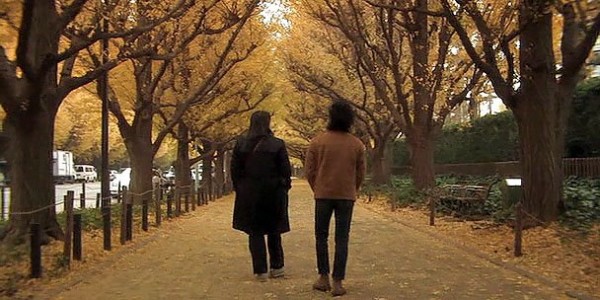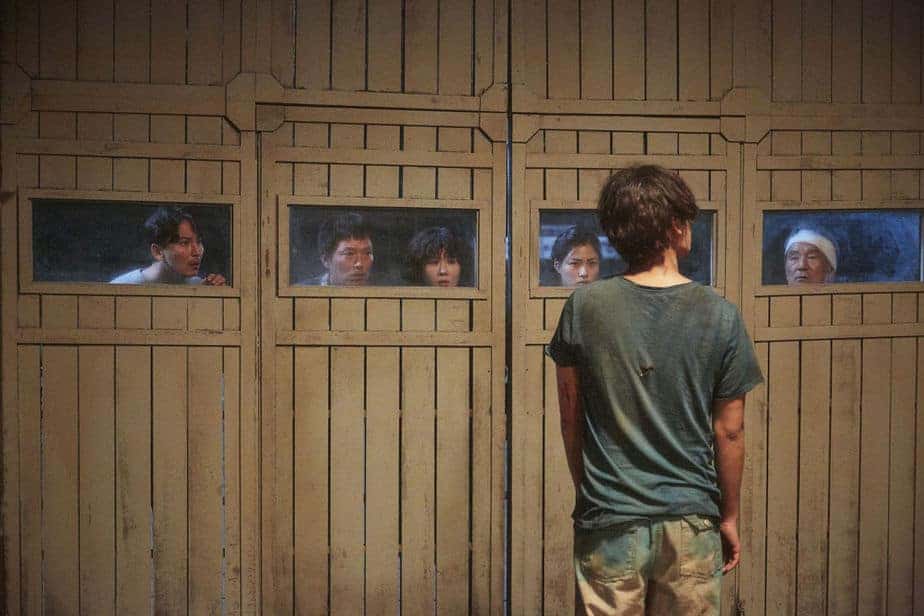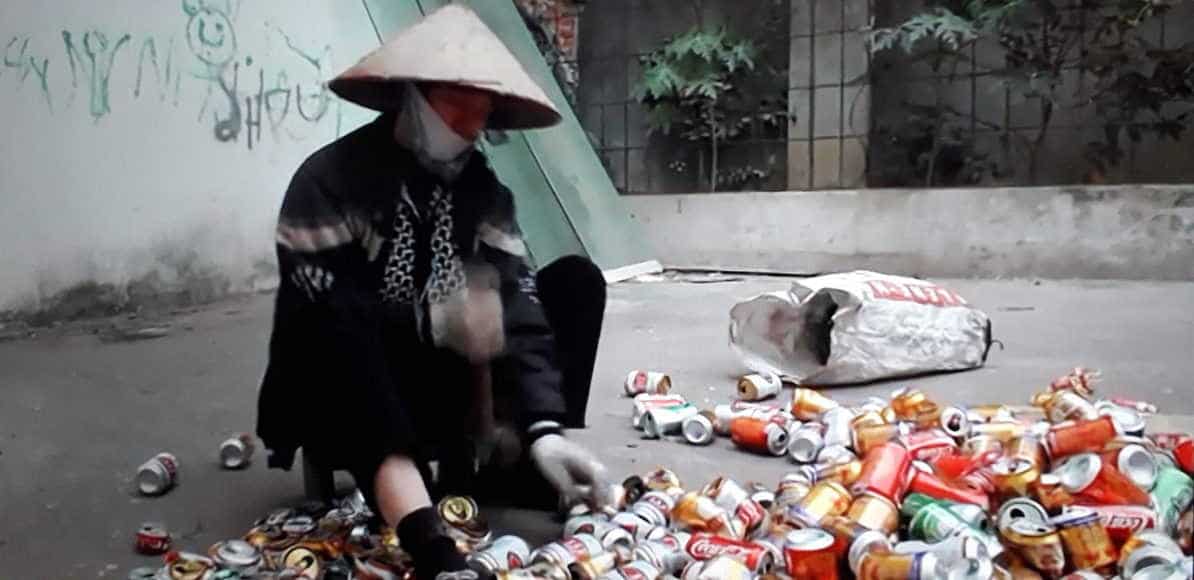“In my 8th college year, buying 3-colour toothpaste I thought could save me from my rock-bottom situation.”
“Adrift in Tokyo” is the sixth feature by Japanese writer and director Satoshi Miki, whose reputation in his home country is based on his work in television, which is much infused with his particular brand of humor. While his films, unlike the work of colleagues like Takashi Miike or Takeshi Kitano, have largely remained unknown to many Western audiences, thanks to the attentiveness of companies such as the UK-based Third Window Films at least some of them can now be enjoyed in decent DVD releases. One of them is “Adrift in Tokyo”, a feature praised by critics and audiences as it was screened in various international festivals.
Buy This Title
Looking at the director, one might be excused to mistake him for one of his protagonists. With his goatee, slacker-like clothes and a floppy heat, Satoshi looks a bit like the Asian version of Johnny Depp's character in “Fear and Loathing in Las Vegas” in many ways. However, as usual, appearances can be deceiving, especially when the director starts talking about his work, his philosophy and his drive towards perfection, the eternal motivation to keep on making films in order to satisfy the urge for that particular goal, one which he admits is especially difficult in comedy, since humor is paradoxically individual but also universal. Satoshi actually was afraid when his features were screened outside his home country and released in Europe or in the USA, but then relieved, as he heard about their positive reception.
In an interview with Spencer Lloyd Peet, Satoshi mentions that his work is heavily influenced by the comedy of Monty Python as well as the works of David Lynch. Perhaps it is these influences, among others, which have shaped his approach towards the medium of film, to be “liberal and … open-minded” about everything, which is, ironically, a character trait many of his female and male characters lack in their lives.

“Adrift in Tokyo” is, similar to his other features, a blend of comedy and drama, this time dealing with issues such as family and loneliness. Additionally, it is a story about Tokyo, its many faces and its people.
Fumiya (Joe Odagiri) is a law student leading a lazy life away from any classes, staying either in his apartment or in video game parlors. Given his gambling addiction, he has accumulated a large amount of debts over the months which makes the appearance of Aiichiro (Tomokazu Miura), a debt collector, necessary Aiixhiro gives him three more days to pay back everything.
However, since he realizes Fumiya is both too lazy and too broke to pay back anything, he makes him an offer: to accompany him on several walks through Tokyo, which will eventually end up in the Kasumigaseki part of the Chiyoda district. Even though he finds the offer rather suspicious, Fumiya sees no other option but to accept. On their seemingly aimless walks that take them through most of the districts of the capital, he listens to Aiichiro's stories, the reason they eventually have to go to Kasumigaseki and what they are supposed to do there. But Fumiya also faces the choices in his life and how they have led to his current situation.
As with every journey, there is usually an aim, otherwise the whole enterprise might be considered pointless or absurd like Samuel Beckett's Vladimir and Estragon waiting for some dubious figure who might or might not arrive at some point to give their actions some meaning. The audience, however, knows, or at least suspects whoever Godot is, he will never arrive, considering the unknown, but rather long time these two must have been waiting for him already.

Much like Beckett, Satoshi Miki's film takes about a couple of minutes to explain the destination of the journey, questioning the definition of Kasumigaseki not as their goal but as the sole purpose for their walking. In a long planned sequence, the direction of their walking, from right to left, already suggests a much deeper purpose, one which goes back rather than forward in terms of their personal histories. At the same time, their walk is constantly interrupted by random events such as the delicious smell of a street vendor's cooking or a whole display of oranges which has fallen in their way, with the apologetic salesman hunting after each piece of fruit. Chance encounters and events on the way towards a past, or rather an encounter with links to the past shown in a long shot probably associated with a certain stage-like quality of the actions we are about to see, a series of events, some funny and some of a more melancholic nature. But one thing is for certain, the constant backdrop is not just the two men putting one foot in front of the other, but also the setting, the city of Tokyo and its different faces.
The term “adrift” in the title hints at a certain state of being lost, without orientation, a condition which becomes more and more apparent as a metaphor for the lives of these two men. For Fumiya, life has lost its direction long ago, ranging from the disappearance of his father, and without any goal in his studies, he has grown accustomed to the “being adrift” following peculiar methods, such as the acquisition of three-colored toothpaste, to escape his current condition. Apparently, even the way he had spent his money seems to be without actual purpose, as he listlessly operates pachinko machines without any notable emotion.
At the same time Aiichiro is probably one of the weirdest debt collectors one could think of, using his socks to intimidate victims and being apologetic for the discomfort he causes his “costumers”. Since money means very little to him – after all he pays Fuyima a large sum of money covering all of his debts to go on aimless walks with him – and the emotional center of his life, the relationship to his wife, is forever lost, he is again without aim, on a “strait” as he calls these walks just for the sake of walking.

As any big city, especially one as maze-like as the Japanese capital, welcomes walkers or being lost within its architectural structures, walking through the various districts of Tokyo is the perfect place for two people as adrift as the two protagonists. Whether it is the colorful surface of Shinjuku or the municipal areas, such as Kasumigaseki, in Chiyoda, Satoshi Miki's film shows the various aspects of the city, albeit, as he repeatedly has claimed, without any of the tourist attractions one might hope for. The urban landscape offers various distractions and pleasures, alleys and side roads leading astray and further away from the aim Aiichiro has set, who instead encourages his companion to follow whatever idea or destination he fancies. In the end, the whole accumulation of experiences might account for re-connecting with a sense of aim more helpful or rewarding than any geographical entity. Just like riding a roller coaster, which might be something for young boys and girls, it is something which needs to be done, and in the end, the various stages of feeling adrift just might lead back to a place you have been searching for without knowing.
“Adrift in Tokyo” is in many ways just like the journey of its two main protagonists, seemingly aimless but filled with humor and many rather touching moments. Based on the great chemistry between its two leads and wonderful cinematography by Sohei Tanikawa (“Love Exposure”), “Adrift in Tokyo” makes for perhaps the most convincing show of talent for its director, cast and crew. In the end, open-mindedness nearly always pays off, at least in the melancholic-crazy universe of Satoshi Miki.
Sources:
1) Peet, Spencer Llloyd (2012) Interview: Miki Satoshi – Inventive Director of Adrift in Tokyo & Instant Swamp
https://diversejapan.wordpress.com/2012/03/07/interview-miki-satoshi-inventive-director-of-adrift-in-tokyo-instant-swamp/, last accessed on: 09/02/2018
2) Satoshi Miki & Fuse Eri (Interview) – “Adrift in [Hyper]Japan” (2012)
https://miniminimovie.com/2012/04/18/satoshi-miki-fuse-eri-interview-adrift-in-hyperjapan/, last accessed on: 09/02/2018
3) asianwiki.com/Satoshi_Miki, last accessed on: 09/02/2018
















